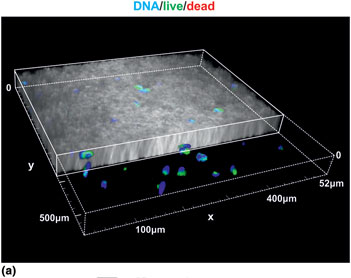Crossref Citations
This article has been cited by the following publications. This list is generated based on data provided by
Crossref.
Tronser, Tina
Laromaine, Anna
Roig, Anna
and
Levkin, Pavel A.
2018.
Bacterial Cellulose Promotes Long-Term Stemness of mESC.
ACS Applied Materials & Interfaces,
Vol. 10,
Issue. 19,
p.
16260.
Martín-Martín, Yolanda
Fernández-García, Laura
Sanchez-Rebato, Miguel H.
Marí-Buyé, Núria
Rojo, Francisco J.
Pérez-Rigueiro, José
Ramos, Milagros
Guinea, Gustavo V.
Panetsos, Fivos
and
González-Nieto, Daniel
2019.
Evaluation of Neurosecretome from Mesenchymal Stem Cells Encapsulated in Silk Fibroin Hydrogels.
Scientific Reports,
Vol. 9,
Issue. 1,
Curvello, Rodrigo
Raghuwanshi, Vikram Singh
and
Garnier, Gil
2019.
Engineering nanocellulose hydrogels for biomedical applications.
Advances in Colloid and Interface Science,
Vol. 267,
Issue. ,
p.
47.
Sheard, Jonathan J.
Bicer, Mesude
Meng, Yiming
Frigo, Alessia
Aguilar, Rocío Martínez
Vallance, Thomas M.
Iandolo, Donata
and
Widera, Darius
2019.
Optically Transparent Anionic Nanofibrillar Cellulose Is Cytocompatible with Human Adipose Tissue-Derived Stem Cells and Allows Simple Imaging in 3D.
Stem Cells International,
Vol. 2019,
Issue. ,
p.
1.
Bicer, Mesude
Sheard, Jonathan
Iandolo, Donata
Boateng, Samuel Y.
Cottrell, Graeme S.
and
Widera, Darius
2020.
Electrical Stimulation of Adipose-Derived Stem Cells in 3D Nanofibrillar Cellulose Increases Their Osteogenic Potential.
Biomolecules,
Vol. 10,
Issue. 12,
p.
1696.
Gupta, Guddu Kumar
and
Shukla, Pratyoosh
2020.
Lignocellulosic Biomass for the Synthesis of Nanocellulose and Its Eco-Friendly Advanced Applications.
Frontiers in Chemistry,
Vol. 8,
Issue. ,
Iandolo, Donata
Sheard, Jonathan
Levy, Galit Karavitas
Pitsalidis, Charalampos
Tan, Ellasia
Dennis, Anthony
Kim, Ji-Seon
Markaki, Athina E.
Widera, Darius
and
Owens, Róisín M.
2020.
Biomimetic and electroactive 3D scaffolds for human neural crest-derived stem cell expansion and osteogenic differentiation.
MRS Communications,
Vol. 10,
Issue. 1,
p.
179.
Gorgieva, Selestina
Jančič, Urška
Hribernik, Silvo
Fakin, Darinka
Stana Kleinschek, Karin
Medved, Sergej
Fakin, Tomaž
and
Božič, Mojca
2020.
Processing and functional assessment of anisotropic cellulose nanofibril/Alolt/sodium silicate: based aerogels as flame retardant thermal insulators.
Cellulose,
Vol. 27,
Issue. 3,
p.
1661.
Ng, Jian Yao
Obuobi, Sybil
Chua, Mei Ling
Zhang, Chi
Hong, Shiqi
Kumar, Yogesh
Gokhale, Rajeev
and
Ee, Pui Lai Rachel
2020.
Biomimicry of microbial polysaccharide hydrogels for tissue engineering and regenerative medicine – A review.
Carbohydrate Polymers,
Vol. 241,
Issue. ,
p.
116345.
Das, Rupambika
and
Fernandez, Javier G.
2020.
Cellulose Nanofibers for Encapsulation and Pluripotency Preservation in the Early Development of Embryonic Stem Cells.
Biomacromolecules,
Vol. 21,
Issue. 12,
p.
4814.
Poorna, M.R.
Sudhindran, S.
Thampi, M.V.
and
Mony, Ullas
2021.
Differentiation of induced pluripotent stem cells to hepatocyte-like cells on cellulose nanofibril substrate.
Colloids and Surfaces B: Biointerfaces,
Vol. 198,
Issue. ,
p.
111466.
Dadoo, Nayereh
Zeitler, Sarah
McGovern, Ashlee D.
and
Gramlich, William M.
2021.
Waterborne functionalization of cellulose nanofibrils with norbornenes and subsequent thiol-norbornene gelation to create robust hydrogels.
Cellulose,
Vol. 28,
Issue. 3,
p.
1339.
Koivuniemi, Raili
Xu, Qian
Snirvi, Jasmi
Lara-Sáez, Irene
Merivaara, Arto
Luukko, Kari
Nuopponen, Markus
Wang, Wenxin
and
Yliperttula, Marjo
2021.
Comparison of the Therapeutic Effects of Native and Anionic Nanofibrillar Cellulose Hydrogels for Full-Thickness Skin Wound Healing.
Micro,
Vol. 1,
Issue. 2,
p.
194.
Subhedar, Aditya
Bhadauria, Swarnim
Ahankari, Sandeep
and
Kargarzadeh, Hanieh
2021.
Nanocellulose in biomedical and biosensing applications: A review.
International Journal of Biological Macromolecules,
Vol. 166,
Issue. ,
p.
587.
Curvello, Rodrigo
and
Garnier, Gil
2021.
Cationic Cross-Linked Nanocellulose-Based Matrices for the Growth and Recovery of Intestinal Organoids.
Biomacromolecules,
Vol. 22,
Issue. 2,
p.
701.
Bicer, Mesude
Cottrell, Graeme S.
and
Widera, Darius
2021.
Impact of 3D cell culture on bone regeneration potential of mesenchymal stromal cells.
Stem Cell Research & Therapy,
Vol. 12,
Issue. 1,
Leppiniemi, Jenni
Mutahir, Zeeshan
Dulebo, Alexander
Mikkonen, Piia
Nuopponen, Markus
Turkki, Paula
and
Hytönen, Vesa P.
2021.
Avidin-Conjugated Nanofibrillar Cellulose Hydrogel Functionalized with Biotinylated Fibronectin and Vitronectin Promotes 3D Culture of Fibroblasts.
Biomacromolecules,
Vol. 22,
Issue. 10,
p.
4122.
Deng, Junping
Song, Qun
Liu, Siyuan
Pei, Wenhui
Wang, Peng
Zheng, Liming
Huang, Caoxing
Ma, Mingguo
Jiang, Qing
and
Zhang, Kai
2022.
Advanced applications of cellulose-based composites in fighting bone diseases.
Composites Part B: Engineering,
Vol. 245,
Issue. ,
p.
110221.
He, Ping
Dai, Lei
Wei, Jiasheng
Zhu, Xulong
Li, Jianhui
Chen, Zhirong
and
Ni, Yonghao
2022.
Nanocellulose-based hydrogels as versatile drug delivery vehicles: A review.
International Journal of Biological Macromolecules,
Vol. 222,
Issue. ,
p.
830.
Kyykallio, Heikki
Faria, Alessandra V. S.
Hartman, Rosabella
Capra, Janne
Rilla, Kirsi
and
Siljander, Pia R‐M
2022.
A quick pipeline for the isolation of 3D cell culture‐derived extracellular vesicles.
Journal of Extracellular Vesicles,
Vol. 11,
Issue. 10,





